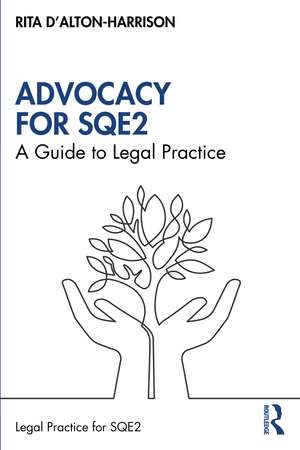Advocacy for SQE2: A Guide to Legal Practice: The Skills of Legal Practice Series for SQE2
Autor Rita D'Alton-Harrisonen Limba Engleză Paperback – 12 aug 2022
Split into the two practice sections that candidates may be tested on – dispute resolution (civil) as well as criminal litigation – the book covers the basics of court procedure in both areas, so that you fully understand the role, duties and responsibilities of an advocate. In line with the requirements of SQE2, it also tests the competency skills required of an advocate in legal practice such as planning and organisation, drafting, legal research, presenting a reasoned argument, witness handling, observation, exercising judgment and the application of knowledge and decision-making. It also includes a range of supporting features, including:
- In Summary sections
- Key Practice Cases
- Practice Tips
- Practice Risks
- Problem Based Exercises
- Realistic Case Scenarios
- Self-Reflection Checklist
Written by an author with practice experience and early involvement in the planning and development of the SQE itself, this unique book will be essential reading for any candidate wishing to be fully prepared for their SQE2 advocacy assessment.
| Toate formatele și edițiile | Preț | Express |
|---|---|---|
| Paperback (1) | 283.14 lei 3-5 săpt. | +29.46 lei 7-13 zile |
| Taylor & Francis – 12 aug 2022 | 283.14 lei 3-5 săpt. | +29.46 lei 7-13 zile |
| Hardback (1) | 1011.64 lei 6-8 săpt. | |
| Taylor & Francis – 12 aug 2022 | 1011.64 lei 6-8 săpt. |
Preț: 283.14 lei
Nou
Puncte Express: 425
Preț estimativ în valută:
54.18€ • 56.68$ • 45.01£
54.18€ • 56.68$ • 45.01£
Carte disponibilă
Livrare economică 12-26 martie
Livrare express 26 februarie-04 martie pentru 39.45 lei
Preluare comenzi: 021 569.72.76
Specificații
ISBN-13: 9780367680879
ISBN-10: 0367680874
Pagini: 340
Ilustrații: 28 Line drawings, black and white; 28 Illustrations, black and white
Dimensiuni: 156 x 234 x 27 mm
Greutate: 0.63 kg
Ediția:1
Editura: Taylor & Francis
Colecția Routledge
Seria The Skills of Legal Practice Series for SQE2
Locul publicării:Oxford, United Kingdom
ISBN-10: 0367680874
Pagini: 340
Ilustrații: 28 Line drawings, black and white; 28 Illustrations, black and white
Dimensiuni: 156 x 234 x 27 mm
Greutate: 0.63 kg
Ediția:1
Editura: Taylor & Francis
Colecția Routledge
Seria The Skills of Legal Practice Series for SQE2
Locul publicării:Oxford, United Kingdom
Public țintă
Bar Vocational Course and Postgraduate lawCuprins
PART A
Introduction
Chapter One - MANAGING YOUR BEHAVIOURS: PROFESSIONALISM AND ETHICS
1.4.1 SRA Code of Conduct
1.5.2 Solicitors’ Disciplinary Tribunal
1.5.3 The Role of the SRA
1.5.4 SRA Enforcement Strategy
1.5.5 Sanctions
In Summary Section
Case in the Spotlight
Practice Tips
Practice Risks
Exercises
Self-Reflection Checklist
References
Chapter Two - DEVELOPING SKILLS OF CASE PLANNING AND ANALYSIS: EFFECTIVE PREPARATION, RESEARCH SKILLS AND STRATEGY
2.1.3 Identify the client’s goals
2.1.4 Know the History of Your case
2.2.2 Evidence Gathering
Case in the Spotlight
Practice Tips
Practice Risks
Exercises
Self-Reflection Checklist
References
Chapter Three - COMMUNICATING WITH OTHERS: EFFECTIVE COMMUNICATION AND WRITTEN SKILLS
3.2.1 Letter Writing Skills
3.2.2 Writing Emails
3.2.3 Note-Taking for Record Purposes
3.4 EFFECTIVE COMMUNICATION SKILLS
3.4.1 Court Communication Etiquette
3.4.2 Communication Through Appearance
3.4.3 Communicating with Vulnerable Clients and Witnesses
3.5.2 Oral Presentation
3.5.3 Use of Voice
3.5.4 Content
3.5.5 Body Language
3.5.6 Persuasion
3.6.2 Cross-Examination
3.6.3 Re-Examination
3.6.4 Questioning Special Groups
3.6.4.1 Defendant in criminal proceedings
3.6.4.2 Spouses
3.6.4.3 Children
3.6.4.4 Hostile Witnesses
3.6.4.5 Protected Witnesses
3.6.5 Challenging a Witness’s Credibility
In Summary Section
Case in the Spotlight
Practice Tips
Practice Risks
Exercises
Self-Reflection Checklist
References
Chapter Four - BUILDING RELATIONSHIPS: WORKING WITH OTHERS IN A PROFESSIONAL CAPACITY
4.1.3 Building Trust and Empathy
4.1.4 Handling Sensitive Situations
4.2 PROGRESSING THE CLIENT’S CASE
4.2.1 Vulnerable Clients
4.3.2 Courtroom Etiquette
4.3.3 Advocate’s Responsibilities to the Court
4.3.4 Upholding Undertakings Given to the Court
4.3.5 The Overriding Objectives
4.3.6 Adhering to Time Limits
4.3.7 Privilege and Public Interest Immunity
4.3.8 Observing Evidential Rules in Court
4.3.9 Respecting the Hierarchy of the Courts and its Precedents
4.3.10 The Courts’ Jurisdiction
4.3.11 The Role of the Jury
4.4 MAINTAINING EFFECTIVE AND PROFESSIONAL RELATIONSHIPS WITH WITNESSES
4.4.1 Competent and Compellable Witnesses
4.4.2 Vulnerable Witnesses
In Summary Section
Case in the Spotlight
Practice Tips
Practice Risks
Exercises
Self-Reflection Checklist
References
PART B
Chapter Five - AN INTRODUCTION TO CRIMINAL LITIGATION
5. INTRODUCTION
5.1 EXCLUDING EVIDENCE
5.1.1 Illegally or Improperly Obtained Evidence
5.1.2 Confessions
5.1.3 Criminal Justice Act Provisions on Hearsay
5.1.3.1 Exceptions to the Hearsay Exclusionary Rule
5.2 CHARACTER AND SIMILAR FACT EVIDENCE
5.2.1 Criminal Justice Act Provisions on Character Evidence
5.2.1.1 Gateways to Admitting Bad Character Evidence of a Defendant
5.2.1.2 Evidence of Motive
5.2.1.3 Evidence of Propensity
5.3 Defendant’s Good Character
5.4 Silence at the police station
5.4.1 Silence at the Trial
5.4.2 Silence on Arrest
5.4.3 Other Examples of Silence as Evidence
5.4.4 Privilege Against Self-Incrimination
5.5 PRE-TRIAL APPLICATIONS
5.6 THE CRIMINAL CASE STUDY
5.6.1 Exercise 1 (Bail)
5.6.2 Exercise 2 (Specific Disclosure)
5.6.3 Exercise 3 (Hearsay and Character Evidence)
Self-Reflection Checklist
References
Chapter Six - AN INTRODUCTION TO CIVIL LITIGATION
7.3 TRIAL BUNDLES
7.4 Opening Speeches
7.4.1. Closing Speeches
7.4.2. The Judge’s Summing-Up (Jury Trials only)
7.5 VERDICTS AND JUDGMENTS
7.5.1 Newton Hearings (criminal cases)
7.5.2 Sentencing (criminal cases)
7.5.3. Enforcement of Judgments (civil cases)
7.5.4. Costs
7.5.5. Finality of Litigation
7.7.2 Exercise 2 (Grounds of Appeal)
Self-Reflection Checklist
References
Appendix A
Table of Key Procedural Rules
Appendix B
Table of Key Evidential Rules
PART C
Suggested Answers for Part A chapter one
Suggested Answers for Part A chapter two
Suggested Answers for Part A chapter three
Suggested Answers for Part A chapter four
Suggested Answers for Part B chapter five
Suggested Answers for Part B chapter six
Suggested Answers for Part B chapter seven
Introduction
Chapter One - MANAGING YOUR BEHAVIOURS: PROFESSIONALISM AND ETHICS
- INTRODUCTION
- ETHICS, PROFESSIONALISM AND JUDGMENT
- THE SRA STATEMENT OF SOLICITOR COMPETENCE1.2.1 Acting Honestly and with Integrity
- PROFESSIONALISM AND ETHICS
- SRA Principles
- Public Trust and Confidence
- Integrity
- Honesty
1.4.1 SRA Code of Conduct
- Conflict between the Principles and the Code
- WORKING WITHIN THE LIMITS OF COMPETENCY AND UNDER SUPERVISION
1.5.2 Solicitors’ Disciplinary Tribunal
1.5.3 The Role of the SRA
1.5.4 SRA Enforcement Strategy
1.5.5 Sanctions
In Summary Section
Case in the Spotlight
Practice Tips
Practice Risks
Exercises
Self-Reflection Checklist
References
Chapter Two - DEVELOPING SKILLS OF CASE PLANNING AND ANALYSIS: EFFECTIVE PREPARATION, RESEARCH SKILLS AND STRATEGY
- INTRODUCTION
- FACT FINDING
2.1.3 Identify the client’s goals
2.1.4 Know the History of Your case
- Identify the Issues
- OBTAINING ADDITIONAL DOCUMENTS AND MATERIALS
2.2.2 Evidence Gathering
- LEGAL RESEARCH
- Researching Cases
- Research Trail
- Citing Cases
- RESEARCHING LEGISLATION
- Statutory Interpretation
- The Literal rule
- The Golden Rule
- The Mischief Rule
- The Purposive Rule
- CASE PLANNING
- Using a Focused Strategy
- Identify the elements of the charge/claim
- Identifying Risks
- NEGOTIATION SKILLS
- Negotiated Settlements
- Making Offers and Concessions
- CASE PLANNING
- The Jurisdiction of the Court
- Pre-Action Protocols
- Drafting Witness Statements and Defence Statements
- Meeting Time Limits
- Damages and Interest
- Costs
Case in the Spotlight
Practice Tips
Practice Risks
Exercises
Self-Reflection Checklist
References
Chapter Three - COMMUNICATING WITH OTHERS: EFFECTIVE COMMUNICATION AND WRITTEN SKILLS
- INTRODUCTION
- EFFECTIVE WRITING AND DRAFTING
- Drafting Case Documents (‘Statements of Case’)
3.2.1 Letter Writing Skills
3.2.2 Writing Emails
3.2.3 Note-Taking for Record Purposes
3.4 EFFECTIVE COMMUNICATION SKILLS
3.4.1 Court Communication Etiquette
3.4.2 Communication Through Appearance
3.4.3 Communicating with Vulnerable Clients and Witnesses
- Communicating with Vulnerable Clients and Witnesses
- EFFECTIVE ADVOCACY
3.5.2 Oral Presentation
3.5.3 Use of Voice
3.5.4 Content
3.5.5 Body Language
3.5.6 Persuasion
- How to Formulate Legal Arguments
- TRIAL QUESTIONING
3.6.2 Cross-Examination
3.6.3 Re-Examination
3.6.4 Questioning Special Groups
3.6.4.1 Defendant in criminal proceedings
3.6.4.2 Spouses
3.6.4.3 Children
3.6.4.4 Hostile Witnesses
3.6.4.5 Protected Witnesses
3.6.5 Challenging a Witness’s Credibility
In Summary Section
Case in the Spotlight
Practice Tips
Practice Risks
Exercises
Self-Reflection Checklist
References
Chapter Four - BUILDING RELATIONSHIPS: WORKING WITH OTHERS IN A PROFESSIONAL CAPACITY
- INTRODUCTION
- TREATING CLIENTS WITH COURTESY AND RESPECT
4.1.3 Building Trust and Empathy
4.1.4 Handling Sensitive Situations
4.2 PROGRESSING THE CLIENT’S CASE
4.2.1 Vulnerable Clients
- Disagreements with the Client
- MAINTAINING EFFECTIVE AND PROFESSIONAL RELATIONSHIPS WITH THE COURT
4.3.2 Courtroom Etiquette
4.3.3 Advocate’s Responsibilities to the Court
4.3.4 Upholding Undertakings Given to the Court
4.3.5 The Overriding Objectives
4.3.6 Adhering to Time Limits
4.3.7 Privilege and Public Interest Immunity
4.3.8 Observing Evidential Rules in Court
4.3.9 Respecting the Hierarchy of the Courts and its Precedents
4.3.10 The Courts’ Jurisdiction
4.3.11 The Role of the Jury
4.4 MAINTAINING EFFECTIVE AND PROFESSIONAL RELATIONSHIPS WITH WITNESSES
4.4.1 Competent and Compellable Witnesses
4.4.2 Vulnerable Witnesses
- Special Measures
- MAINTAINING EFFECTIVE AND PROFESSIONAL RELATIONSHIPS WITH EXPERTS
- The Experts’ Written Report
In Summary Section
Case in the Spotlight
Practice Tips
Practice Risks
Exercises
Self-Reflection Checklist
References
PART B
Chapter Five - AN INTRODUCTION TO CRIMINAL LITIGATION
5. INTRODUCTION
5.1 EXCLUDING EVIDENCE
5.1.1 Illegally or Improperly Obtained Evidence
5.1.2 Confessions
5.1.3 Criminal Justice Act Provisions on Hearsay
5.1.3.1 Exceptions to the Hearsay Exclusionary Rule
5.2 CHARACTER AND SIMILAR FACT EVIDENCE
5.2.1 Criminal Justice Act Provisions on Character Evidence
5.2.1.1 Gateways to Admitting Bad Character Evidence of a Defendant
5.2.1.2 Evidence of Motive
5.2.1.3 Evidence of Propensity
5.3 Defendant’s Good Character
5.4 Silence at the police station
5.4.1 Silence at the Trial
5.4.2 Silence on Arrest
5.4.3 Other Examples of Silence as Evidence
5.4.4 Privilege Against Self-Incrimination
5.5 PRE-TRIAL APPLICATIONS
5.6 THE CRIMINAL CASE STUDY
5.6.1 Exercise 1 (Bail)
5.6.2 Exercise 2 (Specific Disclosure)
5.6.3 Exercise 3 (Hearsay and Character Evidence)
Self-Reflection Checklist
References
Chapter Six - AN INTRODUCTION TO CIVIL LITIGATION
- INTRODUCTION
- EXCLUDING EVIDENCE
- Illegally or Improperly Obtained Evidence
- ADMITTING EVIDENCE INTO THE PROCEEDINGS
- Admissions
- Character and Similar Fact Evidence
- Hearsay
- PRIVILEGE AGAINST SELF INCRIMINATION
- INTERIM APPLICATIONS
- Applicants
- Respondents
- THE CIVIL CASE STUDIES
- Exercise 1 (Setting Aside Default Judgment)
- Exercise 2 (Summary Judgment)
- Exercise 3 (Interim Payment)
References
Chapter Seven - TRIALS AND APPEALS - EXCLUDING EVIDENCE
- INTRODUCTION
- AN INTRODUCTION TO TRIALS
- Burden of Proof
- AN INTRODUCTION TO TRIALS
- Burden and Standard of Proof in Criminal Trials
7.3 TRIAL BUNDLES
7.4 Opening Speeches
7.4.1. Closing Speeches
7.4.2. The Judge’s Summing-Up (Jury Trials only)
7.5 VERDICTS AND JUDGMENTS
7.5.1 Newton Hearings (criminal cases)
7.5.2 Sentencing (criminal cases)
7.5.3. Enforcement of Judgments (civil cases)
7.5.4. Costs
7.5.5. Finality of Litigation
- AN INTRODUCTION TO APPEALS
- Appeals in Civil Proceedings
- Appeals in Criminal Proceedings
- Appeal Notice
- Crown Court as an Appeal Court
- Sources of Potential Miscarriages of Justice
7.7.2 Exercise 2 (Grounds of Appeal)
Self-Reflection Checklist
References
Appendix A
Table of Key Procedural Rules
Appendix B
Table of Key Evidential Rules
PART C
Suggested Answers for Part A chapter one
Suggested Answers for Part A chapter two
Suggested Answers for Part A chapter three
Suggested Answers for Part A chapter four
Suggested Answers for Part B chapter five
Suggested Answers for Part B chapter six
Suggested Answers for Part B chapter seven
Notă biografică
Dr Rita D’Alton-Harrison is a senior lecturer, solicitor, author and legal education trainer and adviser and has been teaching in Higher Education for over 20 years both on undergraduate and postgraduate professional courses. Rita has over ten years’ post qualification experience as a solicitor and previously practised in the field of civil and criminal litigation. Rita is also the series editor for the Routledge Legal Practice SQE2 series.
Descriere
Advocacy for SQE2: A Guide to Legal Practice is the first in a new series of books aimed at those preparing for SQE2, providing a comprehensive overview of everything you need to successfully pass the SQE2 advocacy assessment.
















